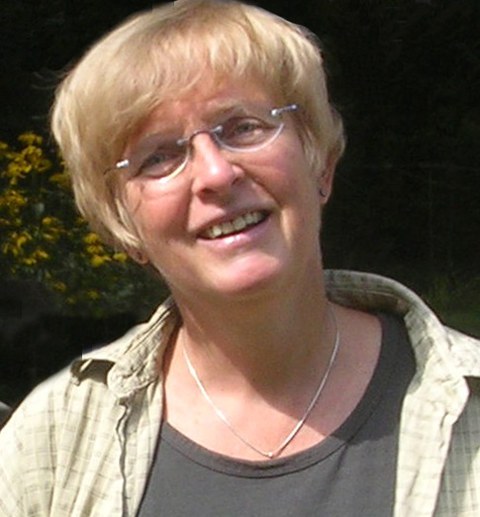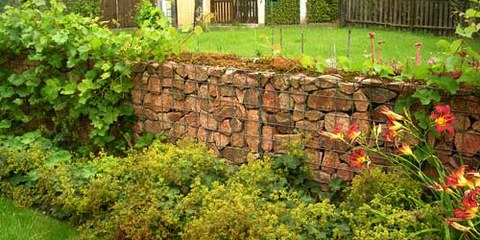Private gardens and highway landscaping
(Interview from 2011)
Dagmar Möbius
Dr. Grit Heinrich would have liked to become a vet. That she ended up studying landscape architecture was thanks to family inspiration. Even if she is one of the few landscape architects with a doctorate, Dr. Grit Heinrich believes "the way you make a name for yourself is through your work."

Dr. Grit Heinrich
On the desk in her Radebeul office are dozens of files. "Those are just the projects in progress," explains Dr. Grit Heinrich. The freelance landscape gardener and landscape architect manages between 10 and 15 projects at any one time. "It can be something of a feat to keep on top of everything," she admits, "but things only get critical when there are multiple issues at once." Interns and graduates are often surprised at all the things that have to be done in parallel.
Landscape architecture was not Grit Heinrich's first choice. She would have liked to become a veterinarian, but for health reasons, nothing came of it. In search of an alternative, she was inspired by her father, who had once studied landscape gardening in Poland. "I got into the subject in 11th grade," says Heinrich, who is from Leipzig. And she was a success. She passed the one-day aptitude test at TU Dresden (TUD). "We had to draw objects and plants freehand, pass a written test – a bit like for PISA – which covered aspects such as practical and spatial conceptual skills, and take an interview."
Before heading to university after graduating from high school with a grade of "very good" ("sehr gut"), Grit Heinrich worked for VEB Grünanlagen in Dresden and qualified as a green space professional in one year. "I wouldn't have gone to university if I hadn't already qualified in a profession," she says, arguing that "you acquire important skills and it was more secure." Looking back, she reasons that her vocational training was "good, because we knew how to hold a spade, what the lines on the paper meant, and how to work outside in all seasons."
Dr. Grit Heinrich studied landscape architecture at TUD from 1982 to 1987. "A well-structured program that taught us a nuanced approach to problems, to work from the big picture to the fine detail and to consider all aspects that indicate a specific job is required," is her assessment of the TUD course.
Today, she says, automatically considering factors such as soil, water, climate, and plants before moving into design helps her coordinate many different fields. Lectures she attended in forestry, civil engineering, architecture, chemistry and computer science in the first two years of her degree laid the foundations for that interdisciplinary approach. She learned a lot from Professor Siegfried Sommer, an "absolute giant in the field of plant knowledge and use." She also thinks back with gratitude to the director of her institute, Professor Harald Linke, her year group coordinator Professor Helmut Trauzettel and her doctoral supervisor, Professor Werner Hempel. "Compared to today, the program was doubtless more like school – and a tough, but extremely good school," she believes. "If things had been more relaxed, we wouldn't have managed everything in those five years." Giving up was never an option. Even if some assignments required night shifts.
After graduating with a Diplom degree, Grit Heinrich completed a doctorate at TUD. she investigated how landscapes can be described and evaluated in detail on the basis of relief and land use in landscape planning together with her colleague Hendrikje Becker. Grit Heinrich finished her doctorate just before reunification and there was some confusion at a university level: "It took seven years before we were able to defend our thesis," she tells us. "TUD fought for us – some people thought there had been no such thing as landscape architecture in the German Democratic Republic (GDR). Maybe it was out of sheer obstinacy on our part that we pulled it off," she suggests with a grin. There are very few doctors in the sector. In everyday competition, however, she says the title does not offer any advantages – although sometimes it does with the authorities. Ultimately, "you make a name for yourself through your work."

A private garden with gabion walls
Relatively quickly, she decided on the self-employment route, after a few, mostly unsatisfactory, job application attempts. She was initially employed by her doctoral colleague. After it was decided that an East German doctorate did qualify them to join the Federal Chamber of German Architects (BAK), she worked in a firm with her colleague Hendrikje Becker from 1990 to 1998. "We were lucky to get a contract for land use and landscape planning in Lusatia relatively early on." After the birth of her son in 1991, Dr. Heinrich worked from home for six months and later returned to the office on an hourly basis. "I can't say I made any money in the first three years," she notes; "I couldn't have done it without family support."
Nevertheless, she was always busy. In 1999, she set up on her own in Radebeul and she now works with a network of colleagues, for example with a drafting firm and a civil engineering firm. "Fortunately, things never got really critical," she says, although there were times when she didn't know what the long-term future would be. "That is in part to do with my philosophy: I do not use loans, and work a lot with freelancers." You can never be really sure about the future, she says; you have no entitlement to projects.
Grit Heinrich plans, designs, and oversees “everything from small private gardens to hospital grounds and highway landscaping”. Landscape architecture offers many opportunities, she tells us, even if projects are on a smaller scale than architects' and new projects are, therefore, needed much more often. Heinrich was responsible for planning a number of projects at the Sächsisches Krankenhaus für Psychiatrie und Neurologie (Saxon Psychiatry and Neurology Clinic) in Arnsdorf. She also planned and did site supervision for Zehren daycare center; Julius-Ambrosius-Hülße-Gymnasium high school school grounds in Dresden-Reick, the Landesgymnasium für Musik high school in Dresden and for the Institute of Musicians' Medicine in Dresden. She was also responsible for the call for entries and for coordinating the competition for the Lingnerallee skatepark project in Dresden. For many years, Grit Heinrich also supervised the greening of sections of Saxon highways. Only supposedly a simple matter, as there could be difficult conditions on the ground. "It's not just about planting a tree," she explains. She is currently designing the last of four courtyards at Stolpen Castle, another project spanning several years.
Dr. Heinrich raises planning and conservation law as a major focus, not least because environmental and planning law has become increasingly strict and complex. Looking back on her 20 years of self-employment, she acknowledges the benefit of having "learned and started together with the public authorities." Young colleagues today often have a harder time, she believes, because they are entering an established system and are expected to have mastered everything already.
However, going into teaching herself is not an option for Dr. Grit Heinrich. "I'm too much of a hands-on person for that," she laughs, bending over a plan of Stolpen Castle again.
Contact details:
Dr.-Ing. (TU) Grit Heinrich
Freie Garten- u. Landschaftsarchitektin
Landschaftsarchitekturbüro
Email: Dr. Grit Heinrich
